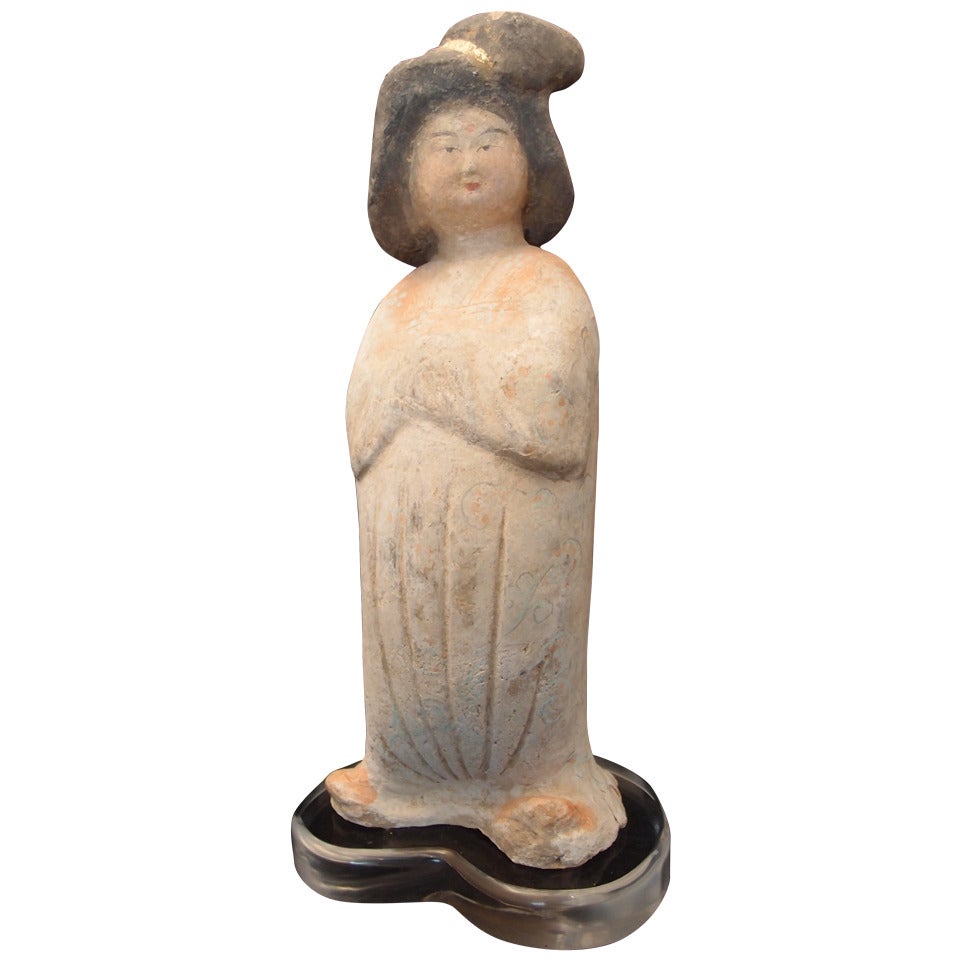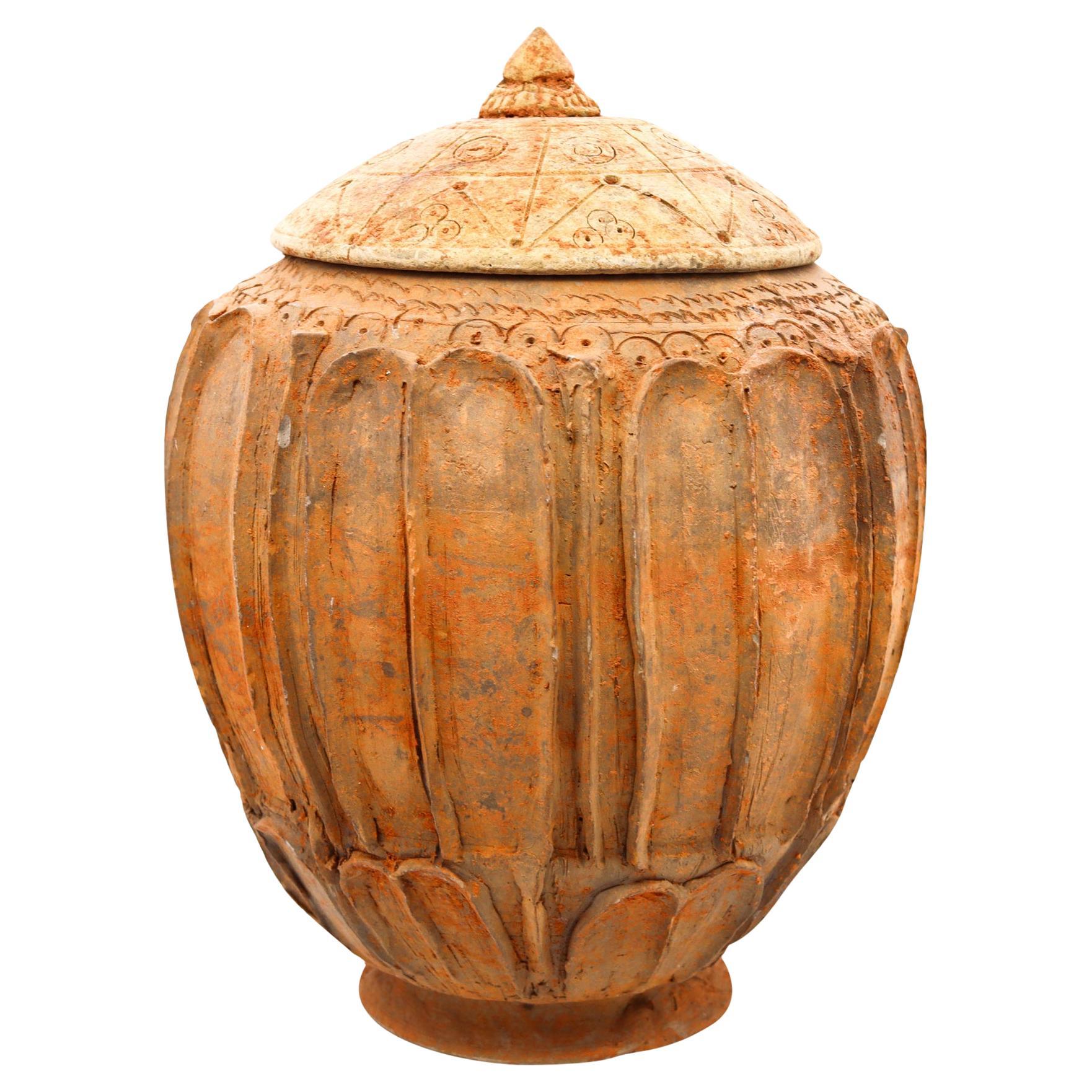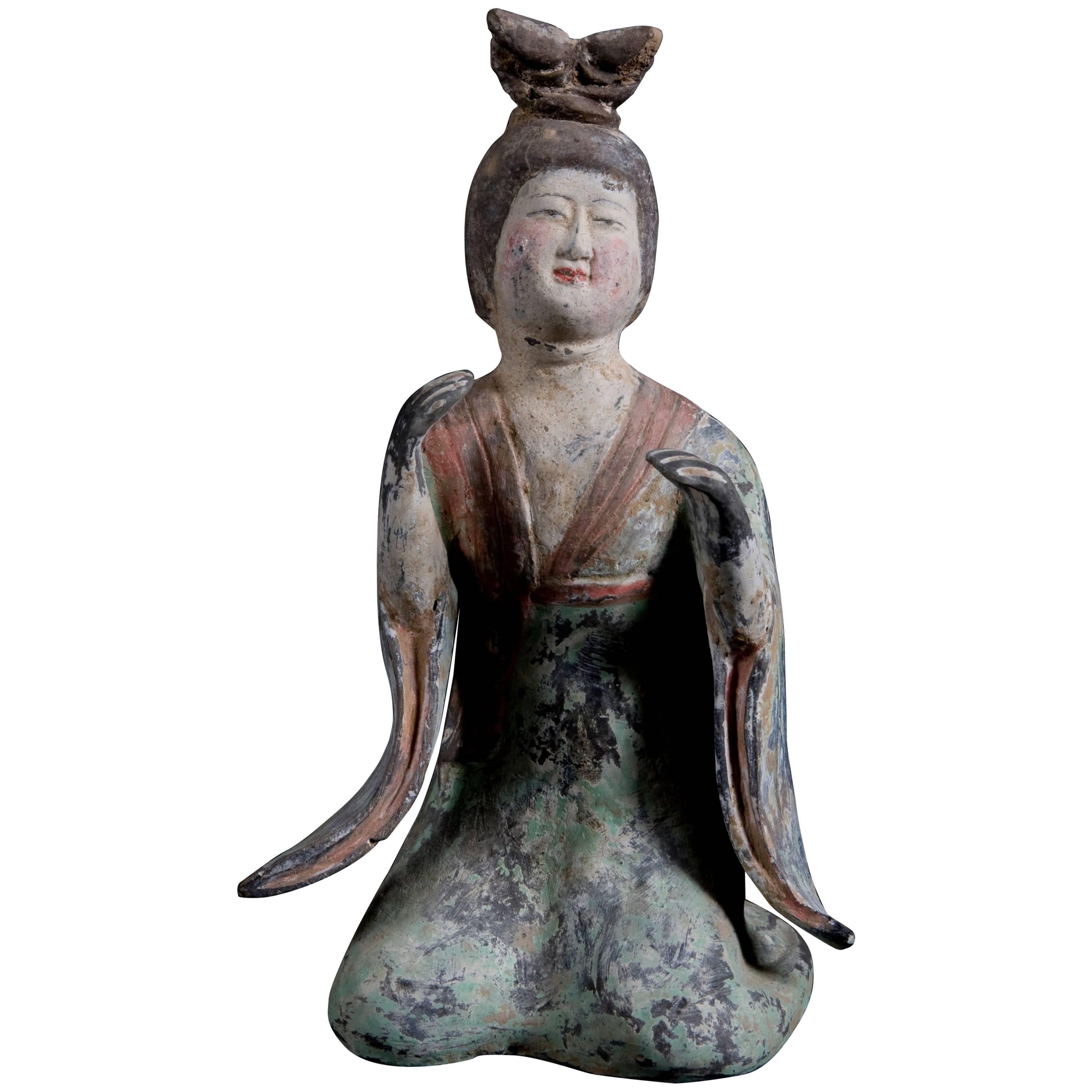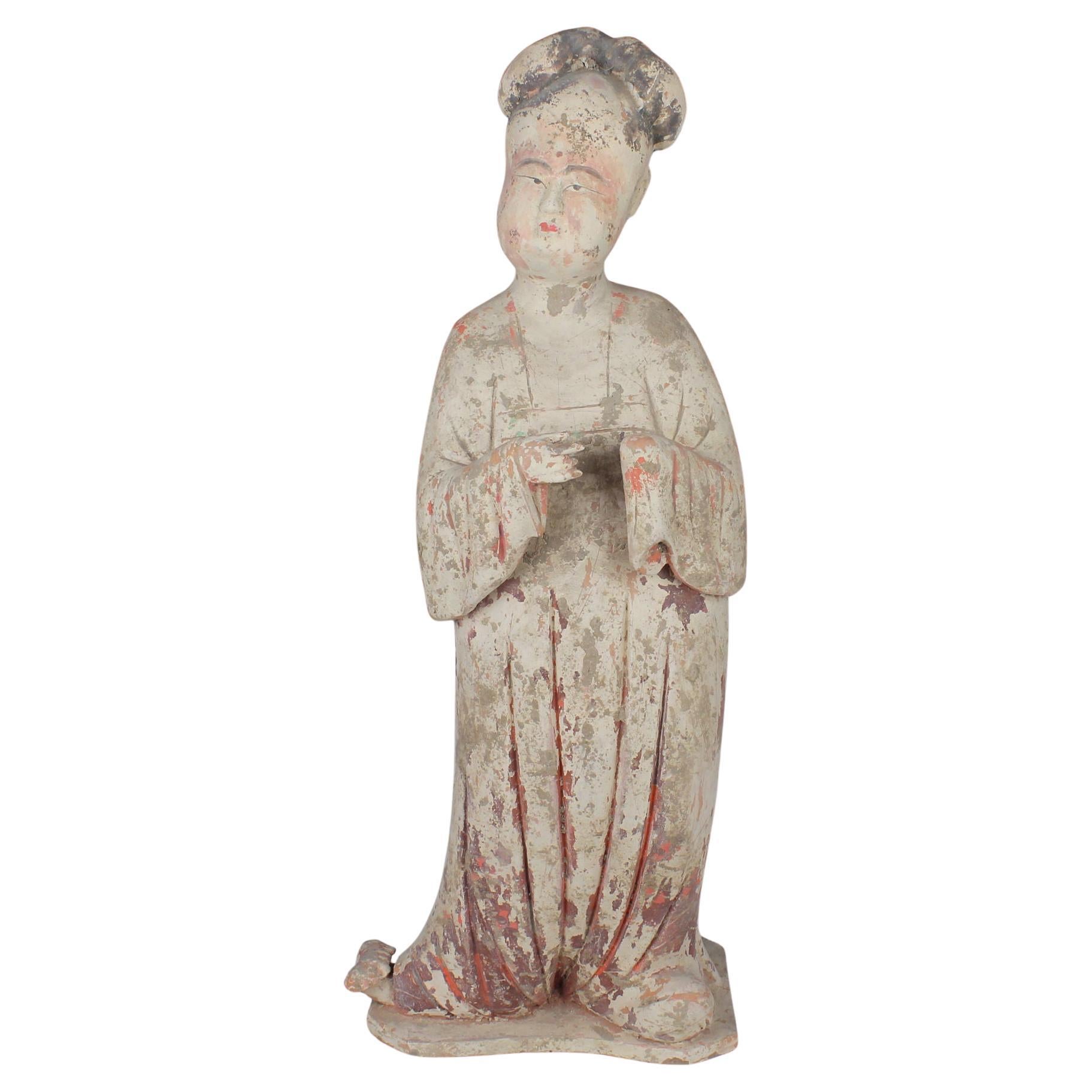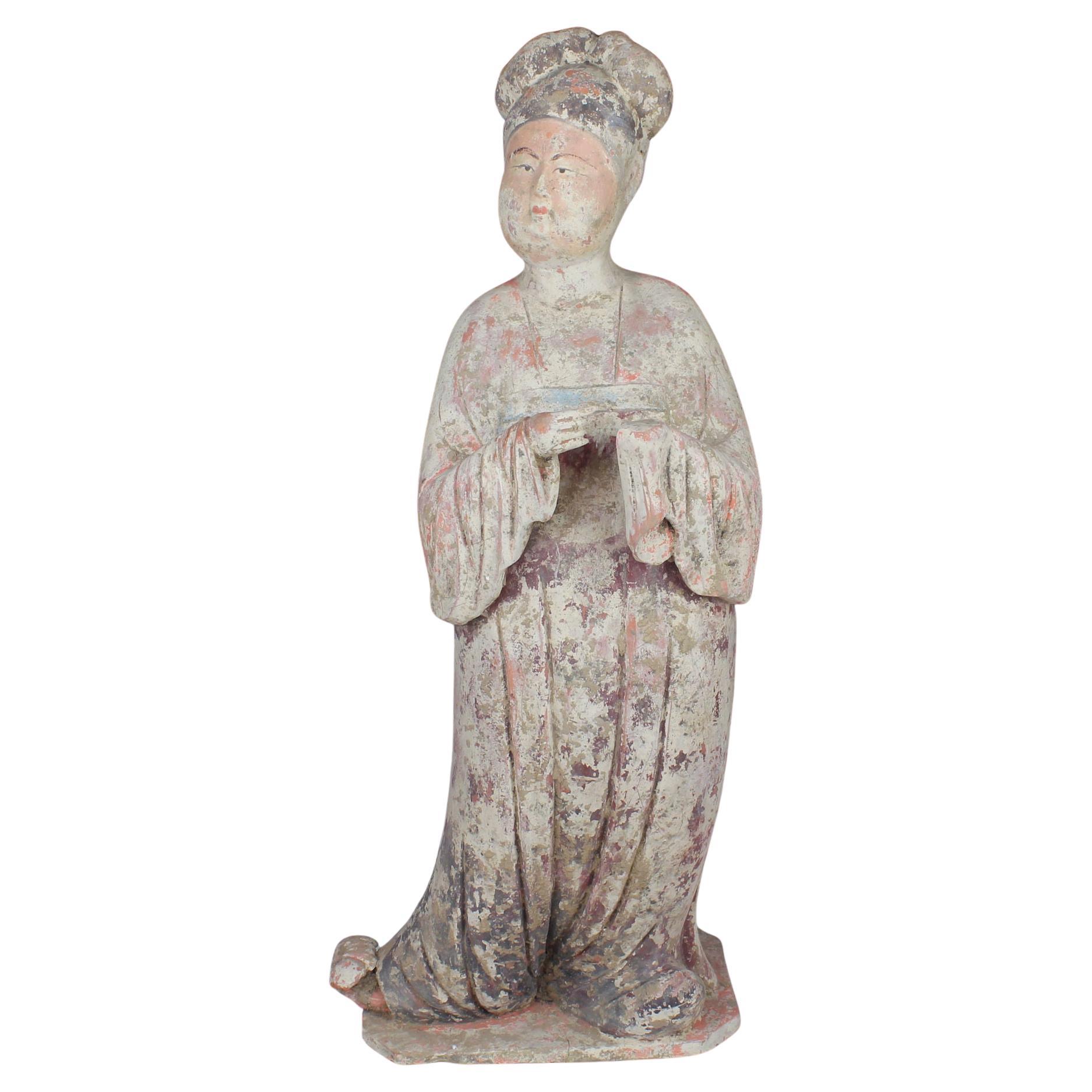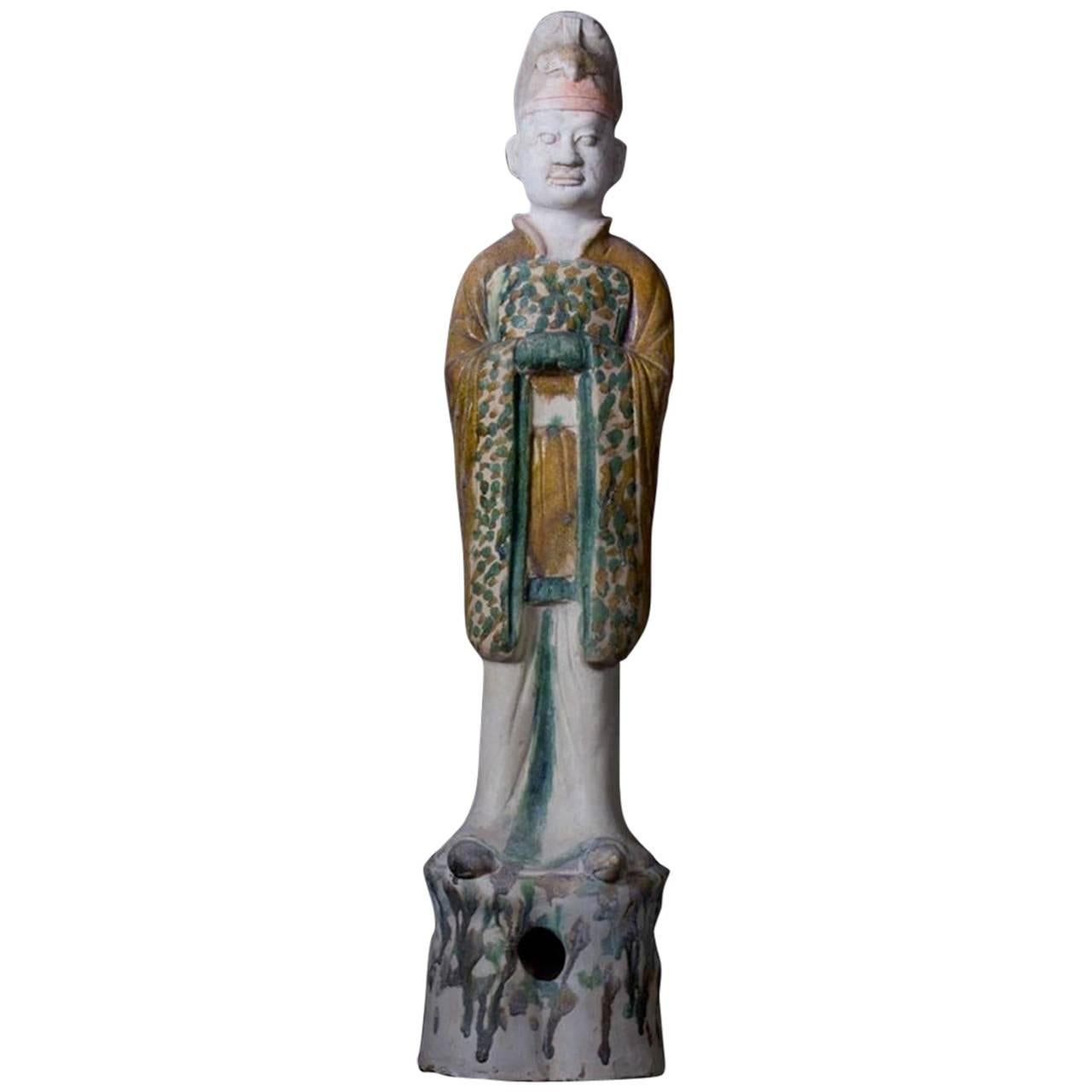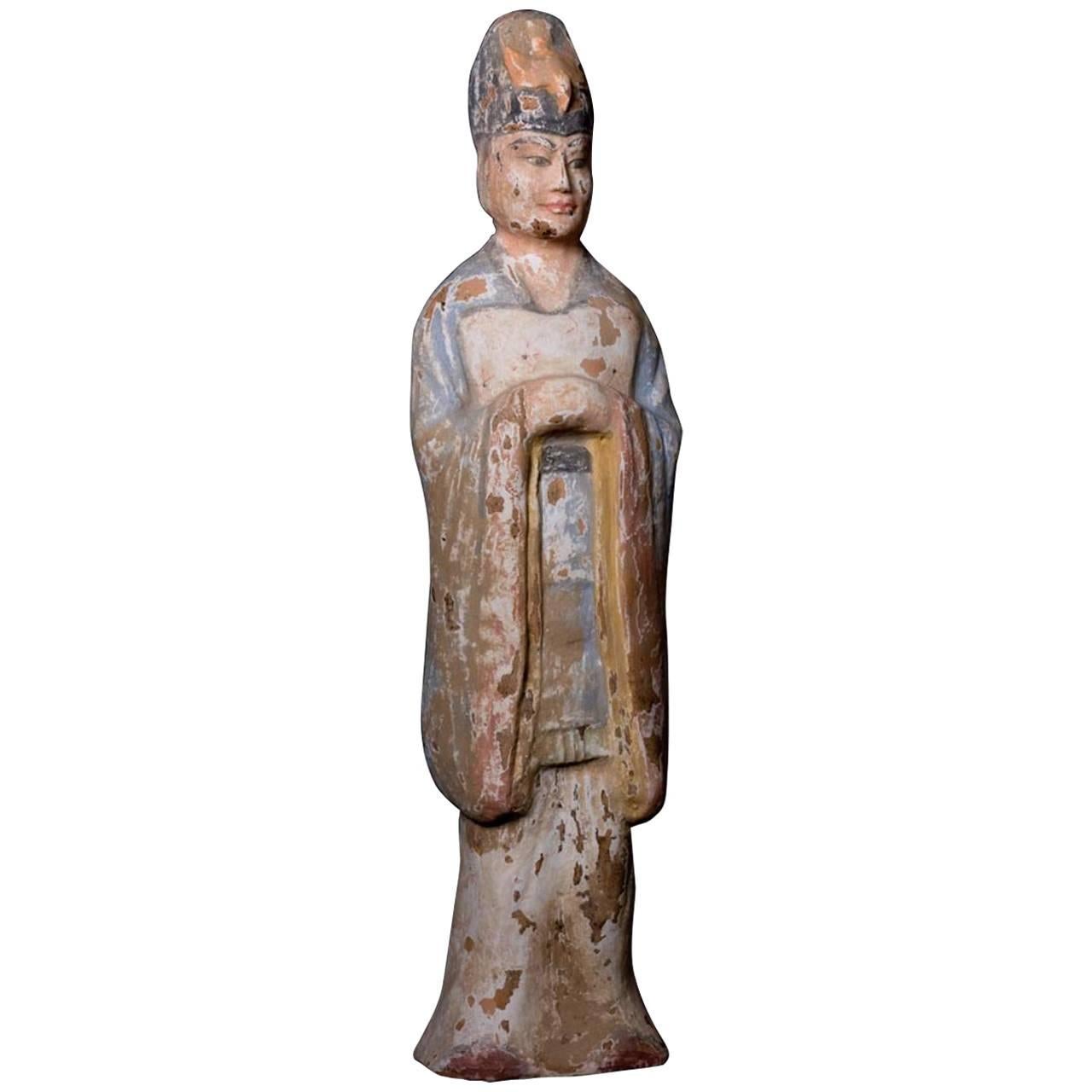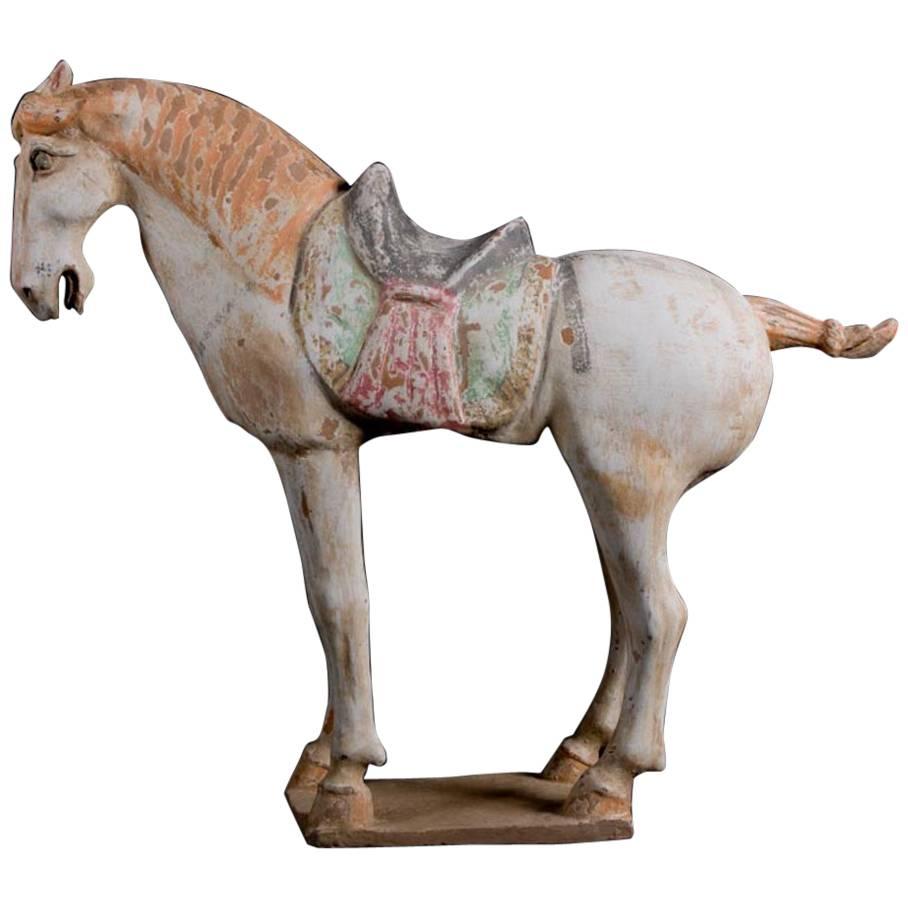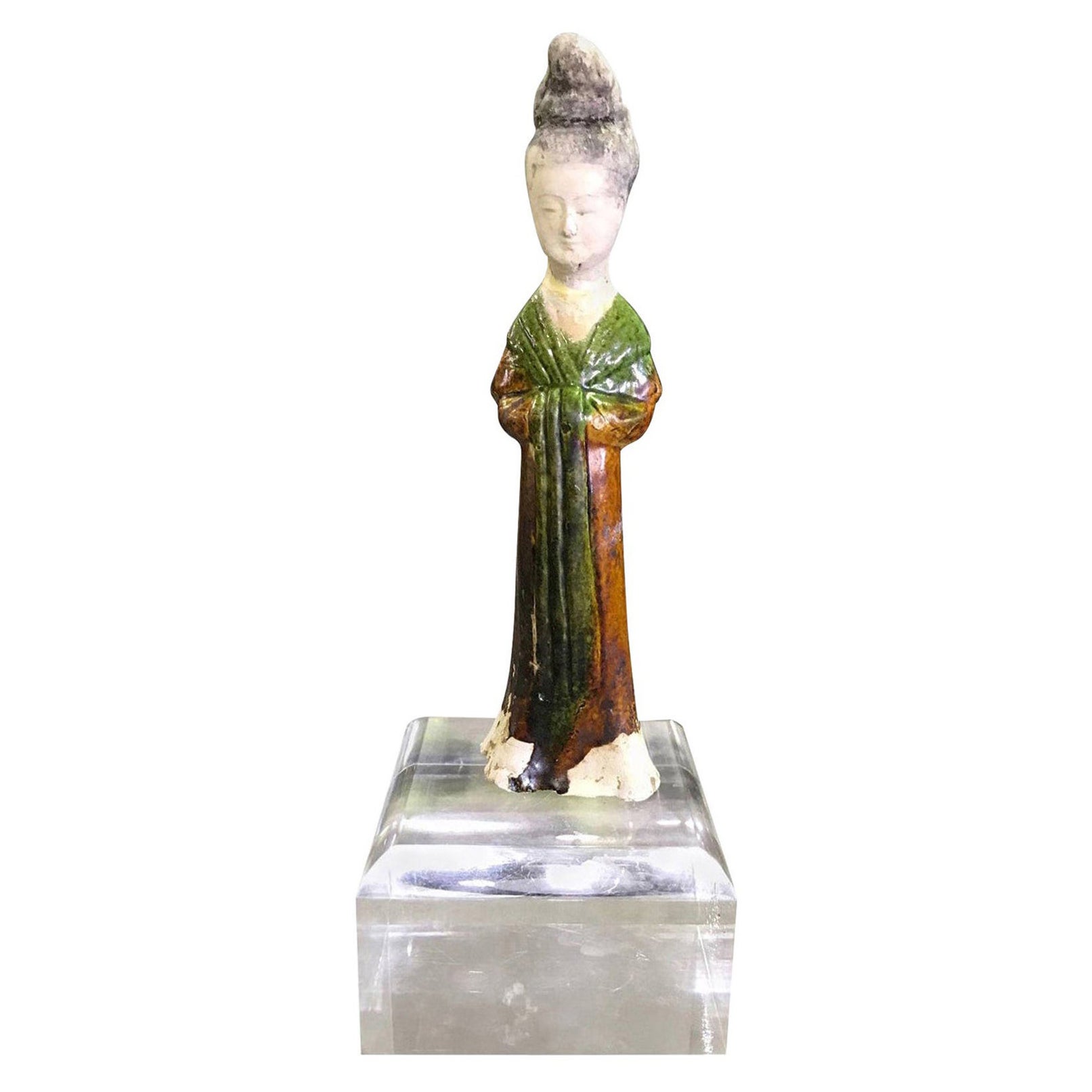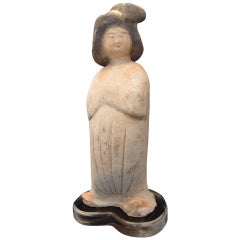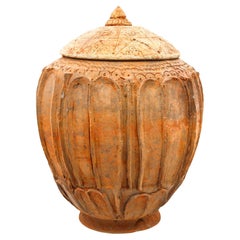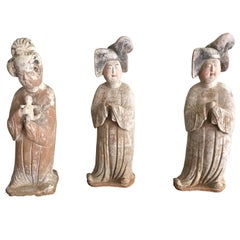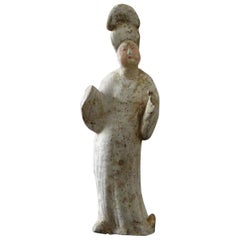
China, Tang Dynasty 618-917, Terracotta Statuette of a Lady of Court Fat Lady
View Similar Items
1 of 12
China, Tang Dynasty 618-917, Terracotta Statuette of a Lady of Court Fat Lady
About the Item
- Dimensions:Height: 13.59 in (34.5 cm)Width: 4.73 in (12 cm)Depth: 3.55 in (9 cm)
- Style:Tang (Of the Period)
- Materials and Techniques:
- Place of Origin:
- Period:
- Date of Manufacture:circa 750
- Condition:Wear consistent with age and use. A thermoluminescence test was carried out in 2001 by the well-known expert firm of Francine Maurer (ASA). This certificate will be given to the purchaser. Some cooking or seniority nights are visible on the right side. No lack or trace of shock.
- Seller Location:Tours, FR
- Reference Number:Seller: 16/10/191stDibs: LU3935312363551
You May Also Like
- Chinese Tang Dynasty Pottery Court LadyLocated in Austin, TXPainted pottery figure of an opulent Chinese court woman with up-swept hair and standing in a simply draped robe from the Tang Dynasty (618-907 AD). Her beauty is illuminated by the ...Category
Antique 15th Century and Earlier Chinese Tang Antiquities
MaterialsPottery
- China 618-907 AD Tang Dynasty Period Pottery Offering Covered Vessel with LotusLocated in Miami, FLOffering vessel from the Chinese Tang Dynasty (618-907 AD). A beautiful "offering spiritual vessel" from the Yunnan province region in the ancient China. This was created in clay earthenware pottery during the Tang Dynasty period between 618 and 907 AD. Featuring molded patterns with incised and high reliefs of geometric figures. The design consists of the bombe baluster-shaped jug and a lid with a spherical knob, which are decorated in relief with 8 panels representing the petals of the lotus flower and linear geometric designs. Has a combined measures including the lid of 10.25 by 7.5 inches (26..03 x 19.05 Cm). Tang dynasty or Tang Empire, was an imperial dynasty of China that ruled from 618 to 907, with an interregnum between 690 and 705. It was preceded by the Sui dynasty and followed by the Five Dynasties and Tend Kingdoms period. Historians generally regard the Tang as a high point in Chinese civilization, and a the golden age of cosmopolitan culture. Tang territory, acquired through the military campaigns of its early rulers, rivaled that of the Han dynasty. The Li family founded the dynasty, seizing power during the decline and collapse of the Sui Empire and inaugurating a period of progress and stability in the first half of the dynasty's rule. The dynasty was formally interrupted during 690–705 when Empress Wu Zetian seized the throne, proclaiming the Wu Zhou dynasty...Category
Antique 15th Century and Earlier Chinese Tang Antiquities
MaterialsClay, Earthenware, Pottery
$2,360 Sale Price / set20% Off - Three Tang Dynasty Fat Ladies 618-907ad Tl Test Authenticity Test !Located in Diest, Vlaams BrabantThree Tang dynasty red pottery court Ladies 618-907 AD (7th-10th century) 1st court Lady long dress with a child graciously in her arms and her hair in a chignon-Thermoluminency test...Category
Antique 15th Century and Earlier Chinese Other Antiquities
MaterialsPottery
- Tang Dynasty Expressive Imperial Court Singer - TL TestedLocated in San Pedro Garza Garcia, Nuevo LeonVery expressive Imperial Court singer dressed in elegant ceremonial robes with long sleeves and hands in motion. Gray terracotta. Thermoluminescense Test by Ralph Kotalla Lab NE: 05K091003 (Worldwide oldest private laboratory specialized in TL testing...Category
Antique 15th Century and Earlier Tang Antiquities
- Chinese statuette of a Fat LadyLocated in EL CAMPELLO, ESITEM: Statuette of a Fat Lady MATERIAL: Pottery CULTURE: Chinese, Tang Dynasty PERIOD: 618 – 907 A.D DIMENSIONS: 645 mm x 260 mm x 180 mm CONDITION: Good condition. Includes Thermoluminescence test by Laboratory Kotalla (Reference 04B101123). Includes Certificate of Authenticity from Dutch gallery PROVENANCE: Ex Belgian private collection, acquired from Dutch art gallery Comes with Certificate of Authenticity and Export Licence. If you are from outside the European Union, we will have to apply for the export licence again for your country, this takes 4 to 6 weeks. Due to the fragility and size of this piece, it can only be shipped within the European Union, United Kingdom and neighbouring countries that can be transported by road by private courier (door to door). This beautifully-finished ceramic attendant was made during what many consider to be China’s Golden Age, the Tang Dynasty. It was at this point that China’s outstanding technological and aesthetic achievements opened to external influences, resulting in the introduction of numerous new forms of self-expression, coupled with internal innovation and considerable social freedom. The Tang dynasty also saw the birth of the printed novel, significant musical and theatrical heritage and many of China’s best- known painters and artists. The Tang Dynasty was created on the 18th of June, 618 AD, when the Li family seized power from the last crumbling remnants of the preceding Sui Dynasty. This political and regal regime was long-lived, and lasted for almost 300 years. The imperial aspirations of the preceding periods and early Tang leaders led to unprecedented wealth, resulting in considerable socioeconomic stability, the development of trade networks and vast urbanisation for China’s exploding population (estimated at around 50 million people in the 8th century AD). The Tang rulers took cues from earlier periods, maintaining many of their administrative structures and systems intact. Even when dynastic and governmental institutions withdrew from management of the empire towards the end of the period – their authority undermined by localised rebellions and regional governors known as jiedushi –the systems were so well- established that they continued to operate regardless. The artworks created during this era are among China’s greatest cultural achievements. It was the greatest age for Chinese poetry and painting, and sculpture also developed (although there was a notable decline in Buddhist sculptures following repression of the faith by pro-Taoism administrations later in the regime). It is disarming to note that the eventual decline of imperial power, followed by the official end of the dynasty on the 4th of June 907, hardly affected the great artistic turnover. During the Tang Dynasty, restrictions were placed on the number of objects that could be included in tombs, an amount determined by an individual’s social rank. In spite of the limitations, a striking variety of tomb furnishings – known as mingqi – have been excavated. Entire retinues of ceramic figures – representing warriors, animals, entertainers, musicians, guardians and every other necessary category of assistant – were buried with the dead in order to provide for the afterlife. Warriors (lokapala) were put in place to defend the dead, while horses/ camels were provided for transport, and officials to run his estate in the hereafter. Of all the various types of mingqi, however, there are none more elegant or charming than the sculptures of sophisticated female courtiers, known – rather unfairly – as “fat ladies...Category
Antique 15th Century and Earlier Chinese Tang Antiquities
MaterialsPottery
- Chinese statuette of a Fat LadyLocated in EL CAMPELLO, ESITEM: Statuette of a Fat Lady MATERIAL: Pottery CULTURE: Chinese, Tang Dynasty PERIOD: 618 – 907 A.D DIMENSIONS: 655 mm x 265 mm x 210 mm CONDITION: Good condition. Includes Thermoluminescence test by Laboratory Kotalla (Reference 05B101123). Includes Certificate of Authenticity from Dutch gallery PROVENANCE: Ex Belgian private collection, acquired from Dutch art gallery Comes with Certificate of Authenticity and Export Licence. If you are from outside the European Union, we will have to apply for the export licence again for your country, this takes 4 to 6 weeks. Due to the fragility and size of this piece, it can only be shipped within the European Union, United Kingdom and neighbouring countries that can be transported by road by private courier (door to door). This beautifully-finished ceramic attendant was made during what many consider to be China’s Golden Age, the Tang Dynasty. It was at this point that China’s outstanding technological and aesthetic achievements opened to external influences, resulting in the introduction of numerous new forms of self-expression, coupled with internal innovation and considerable social freedom. The Tang dynasty also saw the birth of the printed novel, significant musical and theatrical heritage and many of China’s best- known painters and artists. The Tang Dynasty was created on the 18th of June, 618 AD, when the Li family seized power from the last crumbling remnants of the preceding Sui Dynasty. This political and regal regime was long-lived, and lasted for almost 300 years. The imperial aspirations of the preceding periods and early Tang leaders led to unprecedented wealth, resulting in considerable socioeconomic stability, the development of trade networks and vast urbanisation for China’s exploding population (estimated at around 50 million people in the 8th century AD). The Tang rulers took cues from earlier periods, maintaining many of their administrative structures and systems intact. Even when dynastic and governmental institutions withdrew from management of the empire towards the end of the period – their authority undermined by localised rebellions and regional governors known as jiedushi –the systems were so well- established that they continued to operate regardless. The artworks created during this era are among China’s greatest cultural achievements. It was the greatest age for Chinese poetry and painting, and sculpture also developed (although there was a notable decline in Buddhist sculptures following repression of the faith by pro-Taoism administrations later in the regime). It is disarming to note that the eventual decline of imperial power, followed by the official end of the dynasty on the 4th of June 907, hardly affected the great artistic turnover. During the Tang Dynasty, restrictions were placed on the number of objects that could be included in tombs, an amount determined by an individual’s social rank. In spite of the limitations, a striking variety of tomb furnishings – known as mingqi – have been excavated. Entire retinues of ceramic figures – representing warriors, animals, entertainers, musicians, guardians and every other necessary category of assistant – were buried with the dead in order to provide for the afterlife. Warriors (lokapala) were put in place to defend the dead, while horses/ camels were provided for transport, and officials to run his estate in the hereafter. Of all the various types of mingqi, however, there are none more elegant or charming than the sculptures of sophisticated female courtiers, known – rather unfairly – as “fat ladies...Category
Antique 15th Century and Earlier Chinese Tang Antiquities
MaterialsPottery
Recently Viewed
View AllMore Ways To Browse
Pink And White Antique China
Shoe Chinese
Shoe Last
Antique Chinese Shoes
Antique China Shoes
Chinese Court Lady
Antique Shoe Last
Chinese Statuette
Chinese Fat Lady
Antique Antiquity
Antique Antiquities
Antique Furniture Antiquities
Gold Antiquities
Antique 15th
15th Century Antiques
China Antiquity
Antique 15th Century Furniture
China Han
